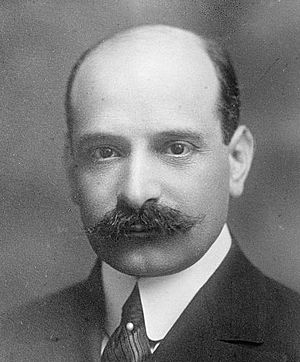Paul Warburg facts for kids
Quick facts for kids
Paul Warburg
|
|
|---|---|

Warburg c. 1910s
|
|
| Vice Chair of the Federal Reserve | |
| In office August 10, 1916 – August 9, 1918 |
|
| President | Woodrow Wilson |
| Preceded by | Frederic Delano |
| Succeeded by | Albert Strauss |
| Member of the Federal Reserve Board of Governors | |
| In office August 10, 1914 – August 9, 1918 |
|
| President | Woodrow Wilson |
| Preceded by | Position established |
| Succeeded by | Albert Strauss |
| Personal details | |
| Born |
Paul Moritz Warburg
August 10, 1868 Hamburg, Germany |
| Died | January 24, 1932 (aged 63) New York City, New York, U.S. |
| Political party | Democratic |
Paul Moritz Warburg (born August 10, 1868 – died January 24, 1932) was an important banker who was born in Germany and later became an American citizen. He is best known for helping to create the Federal Reserve System, which is the central bank of the United States.
Contents
Early Life and Family
Paul Warburg was born in Hamburg, Germany. His family, the Warburg family, was a well-known Jewish banking family with a long history. His parents were Moritz and Charlotte Esther Warburg.
After finishing school in 1886, Paul started learning about business. He worked for different companies in Hamburg, London, and Paris. This helped him understand how banking and trade worked around the world.
In 1891, he joined his family's banking firm, M. M. Warburg & Co., which had been started way back in 1798. He became a partner in the firm in 1895.
In 1895, Paul Warburg married Nina J. Loeb in New York City. Nina was the daughter of Solomon Loeb, who helped start the famous New York investment firm Kuhn, Loeb & Co.. Paul and Nina had two children, a son named James Paul Warburg and a daughter named Bettina Warburg Grimson.
Career and the Federal Reserve
Paul Warburg moved to New York in 1902 and became a partner at Kuhn, Loeb & Co.. Even though he was a big name in German finance, he became an American citizen in 1911.
He quickly became known for strongly supporting the idea of a central bank in America. Many people thought he was the main person who pushed for the creation of the U.S. central bank.
Why America Needed a Central Bank
When Warburg arrived in New York, he felt that the American banking system wasn't organized enough. He thought it needed a central bank, like the ones in Europe, to help keep the financial system stable.
He wrote an important paper called "Defects and Needs of our Banking System" in 1906. In it, he explained that the U.S. banking system was behind other countries. He believed a central bank could help banks lend money more easily and prevent financial problems.
The Panic of 1907 and Reform
His ideas became even more important after the financial crisis of 1907. This crisis showed how unstable the U.S. banking system was without a central authority. Warburg then wrote more articles to explain his plans for a "United Reserve Bank of the United States."
His ideas caught the attention of important leaders. In 1910, he was invited to a secret meeting with other bankers on Jekyll Island in Georgia. There, they worked on a plan for a central bank. This plan was very similar to what Warburg had suggested.
Creating the Federal Reserve Act
The plan from Jekyll Island became the basis for the Federal Reserve Act. This act created the Federal Reserve System, which is still the central bank of the U.S. today. The Federal Reserve helps manage the nation's money supply and keeps the banking system healthy.
Paul Warburg was appointed to the first Federal Reserve Board in 1914. He later served as the Vice Chair of the Federal Reserve from 1916 to 1918.
Later Work and Contributions
After his time at the Federal Reserve, Warburg continued to be a leader in finance. He helped start the American Acceptance Council in 1919 and the International Acceptance Bank of New York in 1921.
He also became a director of the Council on Foreign Relations in 1921, which is a group that studies international relations. He was also involved with the Brookings Institution, a well-known research organization.
In 1929, Warburg warned about the dangers of too much stock market speculation. His warning came just before the Wall Street Crash of 1929, a major stock market crash that led to the Great Depression.
He also supported cultural exchange between Germany and America. He helped create the Carl Schurz Memorial Foundation and gave money to the Warburg Library in Hamburg.
Death and Legacy
Paul Warburg passed away at his home in New York City on January 24, 1932. He was buried in Sleepy Hollow Cemetery.
Paul Warburg is remembered for his crucial role in creating the Federal Reserve System. His ideas helped shape the modern financial system of the United States. The Paul M. Warburg chair in Economics at Harvard University is named in his honor.
Some people believe the cartoon character Oliver "Daddy" Warbucks from the Little Orphan Annie series was inspired by Paul Warburg's life.
Family
His son, James Warburg (1896–1969), became a financial adviser to President Franklin D. Roosevelt during the early years of his presidency.
Images for kids


